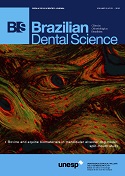Analysis of stress in the walls of simulated artificial root canals during instrumentation with Reciproc system: a pilot study using a photoelastic model
DOI:
https://doi.org/10.14295/bds.2016.v19i3.1278Abstract
Objective: The aim of this pilot study was to perform in vitro analysis of the stress related to instrumentation of artificial root canals with Reciproc System by using the photoelasticity method. Material and Methods: Photoelastic models consisted of two epoxy resin blocks simulating root canals, which were attached with cyanoacrylate adhesive to a base and placed at the centre of a circular polariscope in a dark-field configuration. The Reciproc R25 instrument was mounted to a VDW motor and used in block 1 up to 12 mm (working length) and then the same instrument was used in block 2. The images were captured by video camera and analysed at the time of the fourth penetration. Isochromatic fringes were observed in the cervical, middle and apical thirds at mesial and distal regions of each block. Therefore, they were divided into cervical-mesial (CM), cervical-distal (CD), middle-mesial (MM), middle-distal (MD), apical-mesial (AM) and apical-distal (AD). Results: In the first instrumentation, it was found that the greatest stress occurred at the middle-distal region (1.38), followed by middle-mesial (1.20), apical-distal (1.20) and apical-mesial regions (1.20). In the second instrumentation, the greatest stress occurred at the middle-mesial (1.20), apical-distal (1.20), apical-mesial (1.20) and middle-distal regions (0.90). Conclusion: The greatest stress occurred in the middle and apical thirds during the first instrumentation. Re-utilization caused less stress.
Keywords
Dental Stress Analysis; Endodontic; Instrumentation.
Downloads
Downloads
Published
How to Cite
Issue
Section
License
Brazilian Dental Science uses the Creative Commons (CC-BY 4.0) license, thus preserving the integrity of articles in an open access environment. The journal allows the author to retain publishing rights without restrictions.
=================




























